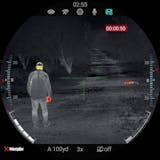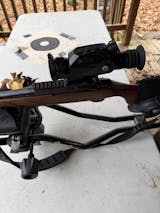
Night Vision Device Maintenance: A Comprehensive Guide to Maximizing Performance and Lifespan
Share
The Importance of Night Vision Device Maintenance
Night vision devices are powerful tools that provide users with the ability to see clearly in low-light conditions. They are essential for a wide range of activities, including hunting, security, military operations, and even outdoor recreation. However, like any sophisticated piece of equipment, night vision devices require proper care and maintenance to ensure optimal performance and longevity. Neglecting maintenance can lead to decreased image quality, reduced lifespan, and potentially costly repairs. This comprehensive guide will explore essential maintenance tips for keeping your night vision device in top shape, extending its lifespan, and maximizing its performance.
Understanding Night Vision Technology: A Foundation for Proper Care
To understand the importance of proper maintenance, it's helpful to grasp the fundamental principles of night vision technology. Most night vision devices utilize an image intensifier tube, a complex and delicate component that amplifies ambient light to create a visible image in low-light conditions. This tube comprises several key elements:
- Photocathode: Converts incoming light into electrons. This is the first stage of light amplification.
- Microchannel Plate (MCP): Multiplies the electrons emitted by the photocathode, significantly amplifying the signal.
- Phosphor Screen: Converts the amplified electron stream back into light, producing a visible image on the screen.
The image intensifier tube is incredibly sensitive to external factors like light, temperature, and physical impact. Proper maintenance safeguards these components and ensures their optimal performance.
Essential Maintenance Tips for Optimal Night Vision Performance
1. Handling with Care: Preventing Damage from the Start
Night vision devices are delicate instruments, and mishandling can lead to costly repairs or even permanent damage. Here are some crucial handling tips:
- Avoid Dropping or Bumping: Even seemingly minor drops or bumps can damage the image intensifier tube and other internal components. Handle your device with care, using a firm grip to prevent accidental drops.
- Use a Protective Case: Invest in a padded carrying case or bag specifically designed for night vision devices. This provides protection during transport and storage, preventing accidental impacts and scratches.
- Minimize Exposure to Harsh Environments: Avoid exposing your night vision device to extreme temperatures, dust, dirt, or moisture. These conditions can lead to condensation, corrosion, and damage to the internal components.
2. Proper Storage: Preserving Your Investment Over Time
Proper storage plays a crucial role in maintaining the lifespan and performance of your night vision device. Follow these storage guidelines:
- Cool and Dry Environment: Store your device in a cool, dry location away from direct sunlight, heat sources, and extreme temperature fluctuations. Ideal storage temperatures are between 50°F and 70°F (10°C to 21°C).
- Use a Dedicated Case: Store your device in its protective carrying case or a dedicated storage container. This shields it from dust, dirt, and accidental damage.
- Silica Gel Packets: Place silica gel packets inside the storage container to absorb moisture and prevent condensation. Replace these packets regularly to ensure they remain effective.
- Avoid Storage in Dusty or Humid Areas: Dusty or humid environments can lead to corrosion and damage to the internal components of your night vision device. Choose a clean and dry storage location.
3. Lens Cleaning: Maintaining Optimal Image Clarity
The lens of your night vision device is critical for optimal image quality. Keeping it clean is essential for clear, sharp images. Follow these lens cleaning procedures:
- Microfiber Cloth Only: Use a soft, microfiber cloth specifically designed for optics. Avoid using harsh chemicals, abrasive materials, or regular lens cleaning solutions, as these can scratch the delicate lens coating.
- Gentle Blowing and Circular Motion: Before cleaning, gently blow off any loose dust or debris. When cleaning, use a circular motion, starting from the center of the lens and moving outwards.
- Avoid Excessive Pressure: Apply only gentle pressure when cleaning the lens. Avoid pressing too hard, as this can scratch the delicate coating.
- Regular Cleaning: Clean the lens after each use, especially if the device has been exposed to dust, dirt, or moisture. Perform a thorough cleaning every few months to maintain optimal performance.
4. Moisture Control: Preventing Internal Damage
Night vision devices are highly susceptible to moisture damage. If your device is exposed to rain, snow, or high humidity, take immediate action to prevent internal damage.
- Immediate Drying: If the device gets wet, gently dry it with a soft, absorbent cloth. Avoid using harsh towels or heat sources, as these can damage the delicate internal components.
- Do Not Force Dry: If condensation forms inside the device, do not attempt to force dry it. This can lead to further damage. Consult a qualified technician for proper drying and repair.
- Preventative Measures: To avoid moisture damage, consider using a waterproof case or cover when operating your night vision device in wet conditions.
5. Regular Inspection: Catching Issues Early
Regular inspections are crucial for identifying any signs of wear, damage, or malfunction. Early detection can prevent small issues from escalating into costly repairs. Perform these regular checks:
- Lens Inspection: Check the lens for any scratches, cracks, or debris.
- Housing Inspection: Inspect the housing for cracks, dents, or loose screws.
- Internal Components: Examine the internal components for any loose or missing parts. Pay close attention to the image intensifier tube for signs of damage, discoloration, or reduced performance.
- Functionality Test: Test the device's functionality by turning it on and verifying that all buttons, controls, and features are operating correctly.
- Professional Inspection: Schedule regular professional inspections by a qualified technician, especially if the device has been subjected to harsh conditions or if you notice any performance issues.
Maintaining Your Night Vision Device's Battery
The battery is a critical component of your night vision device, providing the power needed for operation. Proper battery maintenance ensures optimal performance and extends the device's lifespan.
- Use the Correct Battery Type: Always use the type of battery recommended by the manufacturer. Using the wrong type of battery can damage the device's electronics.
- Store Batteries Properly: Store batteries in a cool, dry place to prevent them from deteriorating.
- Replace Batteries Regularly: Replace batteries even if they still have some charge. Over time, batteries lose their capacity and can cause erratic device performance.
- Turn Off the Device When Not in Use: If your device has a power switch, turn it off when not in use to conserve battery life.
- Avoid Overcharging: Overcharging can damage the battery and shorten its lifespan. Follow the manufacturer's recommendations for charging time and frequency.
Additional Considerations
1. Environmental Factors:
Extreme temperatures, humidity, and dust can all negatively impact your night vision device's performance and lifespan. Consider these factors when storing, transporting, and operating your device.
2. Operating in Harsh Conditions:
If you regularly operate your device in harsh environments, it's crucial to take extra precautions. Using a waterproof case, regularly inspecting for damage, and maintaining the device according to the manufacturer's recommendations are vital.
3. Professional Maintenance:
For complex repairs or maintenance that you are not comfortable performing yourself, always consult a qualified technician specializing in night vision devices. They have the expertise and tools to ensure proper repair and maintenance.
Frequently Asked Questions
Q: How often should I clean my night vision device?
It's a good practice to clean your device after each use, especially if it has been exposed to dust, dirt, or moisture. A thorough cleaning every few months will ensure optimal performance and prevent the build-up of debris that can affect image quality.
Q: What should I do if my night vision device gets wet?
Immediately dry the device with a soft, absorbent cloth. Do not attempt to force-dry it with a hairdryer or other heat source, as this can cause further damage. If condensation forms inside the device, consult a qualified technician for proper drying and repair.
Q: What happens if I drop my night vision device?
Dropping a night vision device can cause significant damage to the delicate internal components. Even a seemingly minor drop can impact the image intensifier tube, leading to reduced performance or even malfunction. If you drop your device, it is essential to have it inspected by a qualified technician to assess the extent of the damage.
Q: Can I use regular lens cleaning solution on my night vision device?
No, most regular lens cleaning solutions are too harsh and can damage the delicate coating on the lens of your night vision device. Use a microfiber cloth specifically designed for optics.
Q: What is the lifespan of a night vision device?
The lifespan of a night vision device can vary depending on factors such as the quality of the device, the frequency of use, and the level of care and maintenance it receives. With proper maintenance, a quality night vision device can last for several years.
Conclusion: Investing in Your Night Vision Device's Future
Following these maintenance tips is essential for extending the life and performance of your night vision device. Regular cleaning, proper storage, careful handling, and timely repairs are all vital for protecting your investment. By taking the time to properly maintain your device, you ensure that it remains a reliable tool for years to come, enabling you to see clearly and confidently in low-light conditions. Remember, prevention is key to avoiding costly repairs and ensuring your device is always ready to perform when you need it most.





